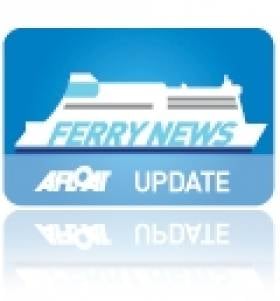Displaying items by tag: Clipper Group
Supramax Bulker Joins Danish Group’s Ferry Subsidiary Seatruck Ships in Dublin Port
#Clipper/Seatruck - A trio of ships from the Clipper Group have used Dublin Port this afternoon, however one of them is not a port regular given the vessel is a bulker and not a routine ro-ro freight ferry trading under subsidiary, Seatruck, writes Jehan Ashmore.
The ‘Supramax’ bulker, Clipper Triton of 61,448dwt had previously called to Cork Harbour at Ringaskiddy’s (DWB) deepwater berth. This procedure of calling first to discharge in Cork followed by Dublin echoes the call of Arklow Shipping’s bulk-carrier, Arklow Spirit.
Likewise of the Irish flagged ship, Clipper Triton is alongside Alexandra Quay West where the dry-bulk facility is located. Also similar to the ASL bulker, is that the Clipper Triton has five cargo holds and that are serviced by four 30.5 metric ton cranes equipped with grabs.
Clipper Group with its headquarters in Denmark, was established in 1972 and has expanded into operating a large mixed fleet comprising of five vessel type categories. More than 200 people work in the Group's offices throughout nine countries around the world. The Group is engaged in chartering and operations departments, fleet and technical management along with shipping services and in corporate functions.
In the bulk-carrier fleet alone, 150 such ships are operated. They range primarily from 28-38,000dwt handysize vessels of to 55-66,000dwt Supramax (incl. Clipper Triton) and Ultramax vessels.
The rest of the mixed fleet are ro-ro freight ferries, car-passenger ferries and a pair of cruiseships. One of them, Silver Discoverer in a previous guise as Clipper Oydessy had visited London/Derry’s city quays, though the vessel's name change occurred in 2013.
The primary activities of the Group’s ro-ro services on Irish Sea are those operated by Seatruck Ferries. Of their 10 strong fleet, four use the original freight-ferry naming theme prefix ‘Clipper’. The balance of the more modern fleet have ‘Seatruck’ to reflect the trading name of the operator’s Irish Sea route network.
An example of this freight-ferry fleet is Clipper Point (5,100dwt), which is berthed at Terminal 5 and where the vessel is to depart this afternoon to Heysham. Also to berth at the terminal’s same linkspan is Clipper Ranger (5,800dwt) having sailed from Liverpool.
Capacity on the Central Corridor route was last month increased to 40 departures weekly. Employed on the service are the aforementioned Clipper Ranger which joined Seatruck Pace along with the larger pairing of sisters, Seatruck Power and Progress.
As Afloat reported this day last week, Seatruck marked a decade of operations in Dublin Port, where on their service to Liverpool was originaly served by single-ship Celtic Star. This chartered ro-ro had used Terminal 3 located also in Alexandra Basin where Clipper Triton will remain until departuring tonight.
In addition to Seatruck, the Group also have passenger ferry services that are co-owned through Clipper Group A/S. They operate an extensive ferry network in Denmark that trade as Danske Færger (Danish Ferries).
Seatruck Ferries Second Ro-Ro Newbuild Launched
The remaining pair are due for delivery in June 2012 from the German shipbuilder Flensburger Schiffbau-Gesellschaft (FSG) located on the Baltic Sea, close to the Danish border.
Seatruck Ferries is a division of the Danish shipping giant Clipper Group, which operates four routes in the north Irish Sea. The company offer 80 sailings per week on four routes: Dublin-Heysham, Dublin-Liverpool, Warrenpoint-Heysham and Larne- Heysham.




























































